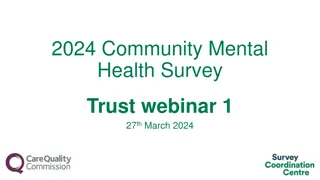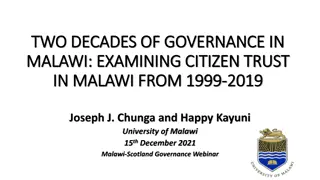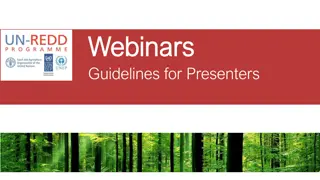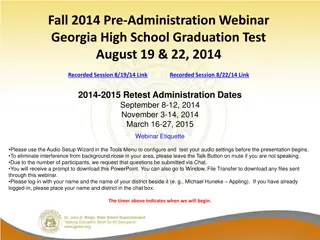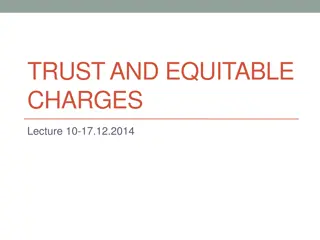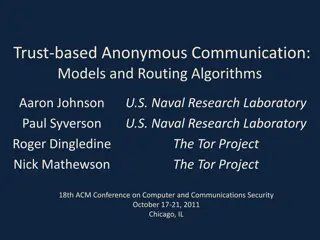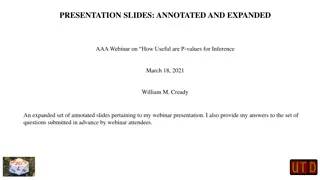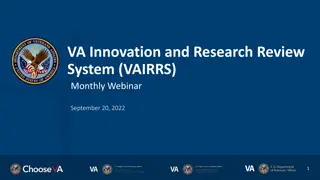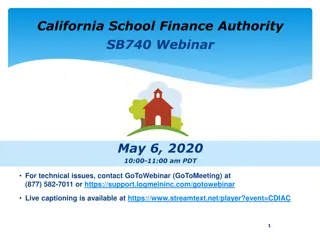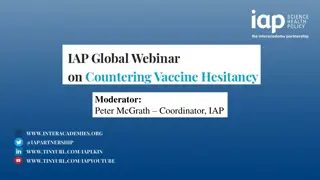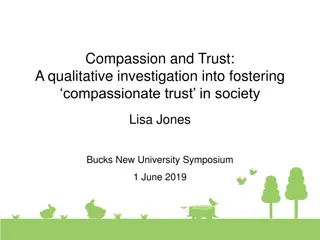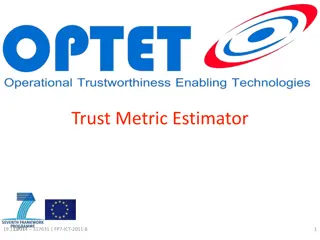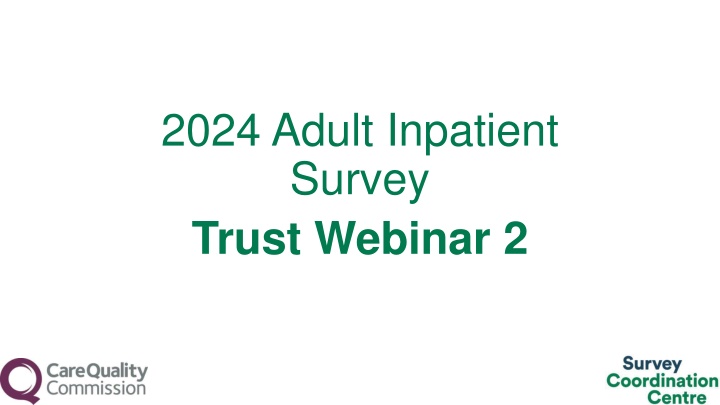
2024 Adult Inpatient Survey Trust Webinar 2 Overview
The 2024 Adult Inpatient Survey Trust Webinar 2 provides an in-depth look at the sampling and contact approach, questionnaire development, data protection requirements, potential sampling errors, DBS checks, and key dates for the survey. It includes details on the mixed-mode approach adopted in 2020, contact methods for different age groups, eligibility criteria for sampling, and changes in the questionnaire based on feedback and consultations. The webinar aims to ensure effective data collection and analysis for the Adult Inpatient Survey.
Download Presentation

Please find below an Image/Link to download the presentation.
The content on the website is provided AS IS for your information and personal use only. It may not be sold, licensed, or shared on other websites without obtaining consent from the author. If you encounter any issues during the download, it is possible that the publisher has removed the file from their server.
You are allowed to download the files provided on this website for personal or commercial use, subject to the condition that they are used lawfully. All files are the property of their respective owners.
The content on the website is provided AS IS for your information and personal use only. It may not be sold, licensed, or shared on other websites without obtaining consent from the author.
E N D
Presentation Transcript
2024 Adult Inpatient Survey Trust Webinar 2
Contents Overview of 2024 Survey [5 mins] Overview of 2024 Survey [5 mins] Sampling and contact approach [20 mins] Sampling and contact approach [20 mins] Questionnaire development [20 mins] Questionnaire development [20 mins] Data Protection and Section 251 requirements [5 mins] Data Protection and Section 251 requirements [5 mins] Potential Sampling errors [5 mins] Potential Sampling errors [5 mins] DBS checks [5 mins] DBS checks [5 mins] Instruction Manuals [5 mins] Instruction Manuals [5 mins] Entering Fieldwork [5 mins] Entering Fieldwork [5 mins] Key dates [5 mins] Key dates [5 mins] Questions [15 mins] Questions [15 mins]
Overview of the 2024 Adult Inpatient Survey
Introductions Mixed mode approach Mixed mode approach was adopted in 2020 and has been carried over for the surveys run since then Contact approach remains the same as 2023 Contact Type Content Postal Aged 79 and under: Push to web, letter containing online survey details & QR code Aged 80+: Letter containing online survey details & paper questionnaire SMS 1st reminder (if mobile number available) Postal 2nd reminder all ages sent letter SMS 3rd reminder (if mobile number available) Postal Final reminder all ages sent letter and paper questionnaire Sampling Eligibility criteria remains same as 2023:16+ years or older and must have spent at least 1 night in a NHS hospital in the last 6 months Questionnaire changes Changes following previous webinars, advisory group meetings, patient focus groups and cognitive interviews will be discussed, but the 2024 survey will keep trend data where possible A close-up of a logo Description automatically generated
Sampling and contact approach
Sampling criteria Eligibility criteria Adult patients (aged 16 and above at time of admission) who have had at least one overnight stay within the trust and were discharged during November 2024 We recommend starting with an initial list of 1,350 patients to allow for any necessary removals following checks. If you anticipate needing to remove >100 patients, start with a larger initial sample of up to 1,550 patients. Please note, some trusts will need to sample back to earlier than November 2024 to meet the required final sample size of 1,250 patients. Patients are considered to have had an overnight stay if they were admitted to hospital and were occupying a bed at midnight Due to an increasing number of patients experiencing their hospital stay in unsuitable areas of hospitals, concerns were raised as to whether the current definition accurately captures eligible patients considering these developments. Potential revisions to the definition of an overnight stay was discussed with CQC and after deliberation, it was decided that for the 2024 adult inpatient survey, the definition will remain the same as previous years. For the 2025 iteration of the survey, changes to the definition to include patients who stayed overnight without occupying a bed, will be explored. A close-up of a logo Description automatically generated
Sampling variables For the 2024 iteration of the adult inpatient survey, sampling variables will remain the same as they were for 2023: Virtual wards indicator NHS number Full date of birth QR codes The NHS number will enable contractors to run centralised DBS checks for trusts. Full date of birth will be collected to enable contractors to run centralised DBS checks. Virtual Ward variable will be included to indicate whether a patient has been transferred to a virtual ward from an inpatients ward. Mailing letters will include a QR code, allowing patients to scan the code on their device. Once scanned they will be taken directly to the online survey. NHS Number: Included in mailing data Should only be transferred to approved contractor for DBS checks Should not be shared with the Survey Coordination Centre Full date of birth: Included in mailing data Should only be transferred to approved contractor for DBS checks Only the year of birth is to be shared with the Survey Coordination Centre This does not change the eligibility of the survey: Patients must have had at least one-night stay in a physical hospital ward Patients must have been discharged from their inpatient stay but can still be on a virtual ward to be eligible This will: Help mitigate the need for the web address Automatically log in patients, bypassing need for their unique password A close-up of a logo Description automatically generated
Contact approach Below are the details for the contact approach confirmed for the 2024 adult inpatient survey. Contractors noted a few issues with previous mailing schedules where patients would sometimes receive SMS reminders before receiving the postal letters. To address this, the main change this year is increasing the number of days between contacts to 5x working days, aligning with other surveys on the NPSP. Time period (working days) Example of mailing days Contact type Content of contact Aged 79 and under: age-tailored invitation letter, multi-language sheet Aged 80+: age-tailoredinvitation letter, multi-language sheet, paper questionnaire, free-post return envelope Week 1 Postal Monday (Day 0 first mailing) Week 2 SMS reminder with unique link to online survey (if mobile number available) (Day 7 5 working days after week 1 contact) SMS Monday Week 3 All ages: reminder letter (age-tailored: 79 and under, 80+) with URL and log-in details for online survey, multi-language sheet (Day 14 5 working days after week 2 contact) Postal Monday Week 4 SMS reminder with unique link to online survey (if mobile number available) (Day 21 5 working days after week 3 contact) SMS Monday Week 5 All ages: final reminder letter, paper questionnaire, freepost return envelope, multi-language sheet (Day 35 10 working days after week 4 contact) Postal Monday A close-up of a logo Description automatically generated
Feedback from cognitive interviews Patient communication - updates Mailing letters Following cognitive interviews, the following updates have been made to communications sent to patients during fieldwork: Patients reported mailing letters were detailed with a respectful and personable tone. Positive attitudes were seen towards the changes made. Patients liked the blue colour scheme, associating this with NHS colours, which inspired confidence in trustworthiness of the letters. Mailing letters: Patient s first name to be included on mailing letter i.e. Dear first name last name Discharge date from hospital to be included Discharge name updated to discharge site name for clarity Additional information added to explanation of data controller Information on accessible formats made more visible SMS guidance The new sentence was well received by patients, encouraging them to take the survey seriously. Patients particularly liked the polite tone of the SMS messages, reporting higher likelihood of completing the survey. SMS guidance: The following sentence please help the NHS by completing this survey has been added to the second SMS reminder MLS Patients appreciated the inclusiveness of the multi- language sheet, and reported the new sentence seemed more personal. Multi-language sheet (MLS): The following sentence please help us to improve NHS inpatient services by completing this survey has been added to all translations A close-up of a logo Description automatically generated
Other survey materials - publicity Press release template Social media cards Website banner Outlines purpose and value of 2024 adult inpatient survey for trusts. Highlights key messages for the survey, to increase engagement and response rate. Provides information about the purpose, value and dates of the survey. Applies You said, We Did principles to demonstrate how patient feedback has been implemented. Includes: social media cards, 1x call to action and 3x reminders. Banners are to be simple in content, with easily digestible information. Can be shared on your social media platforms like Facebook or LinkedIn. Can be tailored to demonstrate how research findings have been used to identify areas of improvements and action change. Banners can be added to websites, email signatures and any other platforms as appropriate. The survey materials included in our publicity activities are currently under review as part of the Section 251 approval process. We anticipate receiving Section 251 approval by Friday 22nd November these materials will be made available to all trusts shortly thereafter. A close-up of a logo Description automatically generated
Accessibility options As per previous iterations of the inpatient survey, there are a variety of accessibility features available for the online survey and paper questionnaire to ensure all patients can complete the survey in line with their individual needs. Online survey A A Change font size Change background colour Screen reader compatible Multiple language options British Sign Language For the paper questionnaire, the following options are available upon request: Easy-read Large print Braille Patients will also have the option to contact a telephone-assisted helpline to request help to complete the paper questionnaire or the online survey. Help is available in approximately 22 languages. A close-up of a logo Description automatically generated
Questionnaire development 2024
Development process In line with the 2023 adult inpatient, this years survey will continue to use a mixed-mode methodology online survey and paper questionnaire. Advisory group meeting Consultation with trusts (1st webinar) Consultation with contractors to discuss learnings from 2023 and new areas for exploration in the 2024 survey Consultation with Trusts (2nd webinar) Consultation with contractors - to discuss sampling process and questionnaire amendments for 2024 November 2024 September 2024 August 2024 October 2024 December 2024 Finalising questionnaire and online survey Cognitive interviews 90- minute virtual interviews with 18x patients from various demographic backgrounds Desk research to explore updates to policies and areas of growing importance in inpatient care Sampling ongoing Patient focus groups 90- minute virtual interviews with 9x patients from various demographic backgrounds Patients included those with experience of individual needs and care in unconventional locations A close-up of a logo Description automatically generated
Questions added for 2024 Questions Rationale Q6 Before you were admitted onto a ward, were you asked to wait in any of the following locations within the hospital? Reports of patients experiencing care in unconventional locations within hospitals has recently been increasing. During the first trust webinar and advisory group meetings, it was noted that patients who wait for extended periods in places like corridors or on trolleys might factor in these experiences into their survey responses. Q7 Thinking about the location(s) selected at Q6, how long did you wait, in total, before you were admitted onto a ward? It was agreed that it is important to capture whether patients experienced this type of care, as well as the location and duration of their waiting times, prior to being admitted onto a ward. Future iterations of the adult inpatient survey may explore this area further, to investigate the facilities / comfort available for patients while waiting and the care received. A close-up of a logo Description automatically generated
Questions updated for 2024 Questions Rationale Q31 Thinking about your care and treatment, did hospital staff take into account the following individual needs? The current question on needs was revised following outcomes from desk research and patient focus groups. It was believed that the old question format did not fully encompass the different types of needs patients may have during their hospital stay, and not capturing this could limit our understanding of patient s experiences of potential health inequalities in their care. Language needs Cultural needs Religious needs Accessibility needs Dietary needs Cognitive interviews further supported the need to revise this question, with patients interviewed showing positive attitudes to the question and the answer options available. Q59 - Recontact question The Care Quality Commission (CQC) may want to conduct further research on your healthcare experience. Are you willing for your answers to be linked to your contact details for this purpose? If you are contacted, you can choose whether to participate or not. New wording added this year for the recontact question. Cognitive interviews showed patients preferred this new version of the text - perceived to be more detailed, and easier to understand. This will not affect the care you receive in any way. The staff at the hospital will not know that you may be contacted for further research. A close-up of a logo Description automatically generated
Questions removed for 2024 Questions Rationale Q12 Were you offered food that met any dietary needs or requirements you had? Question removed to allow new questions with a higher priority to be included for this year. This could include religious, medical, or allergy requirements, vegetarian/vegan options, or different food formats such as liquified or pureed food. Dietary needs included as an answer option in the newly revised Q31 on patients' individual needs. Question removed to allow new questions with a higher priority to be included for this year Q13 How would you rate the hospital food? Q50 During your hospital stay, were you given the opportunity to give your views on the quality of your care? Question removed to allow new questions with a higher priority to be included for this year A close-up of a logo Description automatically generated
Data protection & S251 requirements
GDPR & national data opt-out programme General data protection regulation (GDPR) National Data Opt-Out Programme Management of personal data under GDPR guidelines is stated on the 2nd page for all mailing letters snapshot below. NPSP has received exemption from the National Data Opt- out Programme. 2024 revisions to the mailing letters includes an expansion on the details around data controller for further clarity. We will continue to have separate opt-out mechanisms via the dissent posters that need to be displayed across all trusts. Please note that patients do not have to actively consent to the sharing of their data, for the 2024 adult inpatients survey. A close-up of a logo Description automatically generated
Section 251 requirements: Dissent posters Dissent posters are now available on the NHS patient surveys website for 2024 adult inpatient survey. These provide patients with the option to opt out of the survey, should they wish to do so. They should be displayed in all trusts for the duration of November 2024, to comply with section 251 requirements. Ensure an accurate log of patients who have dissented from taking part in the survey is kept securely. Posters are available in the following languages: Arabic, Bengali, Bulgarian, French, Gujarati, Indian Punjabi, Italian, Kurdish Sorani, Lithuanian, Nepali, Polish, Portuguese, Romanian, Russian, Simplified Chinese, Somali, Spanish, Tamil, Traditional Chinese, Turkish, Ukrainian, Urdu A close-up of a logo Description automatically generated
Potential sampling errors
Sample errors and how to avoid them Below are a list of checks that should be done before you submit your sample to your approved contractor or to the SCC: Check the distribution of patient ages and patient gender in your sample; ensure patients are aged 16 or over at the time of admission Check the distribution of patient admission method Are there any errors in the query used to extract the eligible patient populations? Are there any missing / incomplete data in your initial database? Have the local checks for deceased patients / DBS been done correctly? Be aware of system migrations Ensure patients on the national data opt-out programme are not excluded Ensure patients who have dissented to taking part, are excluded Check all codes provided in your sample are valid Check admission dates are as expected Check admission and discharge sites are correct Ensure ICD-10 codes are present where possible For further detailed information, please refer to the sampling instructions document. A close-up of a logo Description automatically generated
Demographic Batch Service (DBS) checks (1/2) Once you draw your sample of eligible patients, this list must be locally checked for deceased patients AND it must be submitted for demographic batch service (DBS) checks. If there are >2 weeks between the DBS check and the 1st mailing, additional local and DBS checks must be conducted. Before the 2nd and the 3rd mailing, local checks must be conducted (unless your contractor is running these on your behalf). We would also recommend doing another DBS check before each mailing. Contractors running DBS checks on behalf of trusts Some contractors have the capability of running DBS checks during fieldwork on your behalf. If you choose to take this option, you will not have to run DBS and local checks before the 2nd and 3rd mailings. HOWEVER You are still expected to run the initial DBS checks when drawing the sample A close-up of a logo Description automatically generated
Demographic Batch Service (DBS) checks (2/2) DBS & local checks requirements for adult inpatients Local checks AND DBS checks at the time of drawing your sample - (this must be conducted by the trust). Before mailing 1 (further deceased checks may be needed if it has been >2 weeks since DBS checks prior to sample submission and mailing 1 this can be conducted by your contractor if they have the capability). Before SMS 1 No checks required Local checks (+ strongly recommended DBS check) Before mailing 2 Before SMS 2 No checks required Before mailing 3 Local check (+ strongly recommended DBS check) A close-up of a logo Description automatically generated
Instruction Manuals: Survey Handbook For survey leads: Brief document outlining step-by-step process for preparing and running the adult inpatient survey Key summary document that links to all other relevant information regarding the survey instructions Includes: What s new for the 2024 adult inpatient survey Tips on managing the survey Tips on implementing the survey Key dates: top level Highlights on key information e.g. S251 The survey handbook is available for download on the NHS patient survey website. A close-up of a logo Description automatically generated
Instruction Manuals: Sampling Instructions For sample drawers (data team): Brief document outlining step-by-step process of how to draw your sample Key summary document that links to all other relevant information regarding the survey instructions Includes: Overview of the sample drawing process Details on eligible and ineligible patients Information on DBS checks for deceased patients Checking and submitting your sample The sampling instructions document is available for download on the NHS patient survey website. A close-up of a logo Description automatically generated
Instruction Manuals: Sample declaration forms Instruction Manuals: Sample construction spreadsheet To be used to check your sample has been correctly drawn before submission to your contractor or the SCC To be used to construct the sample of eligible patients for the survey Two versions are available depending on whether you will be using a contractor to conduct fieldwork on your behalf or conducing the survey inhouse Two versions are available depending on whether you will be using a contractor to conduct fieldwork on your behalf or conducing the survey inhouse Each version will contain all relevant fields for the sample details, mailing details and fieldwork variables Includes instructions, checklist, declaration agreement Must be signed by the sample drawer AND your Caldicott Guardian prior to submission The sample construction spreadsheet is available for download from the NHS patient survey website The sample declaration form is available for download from the NHS patient survey website A close-up of a logo Description automatically generated
Other NPSP Instruction Documents Other instructional documents that are useful for implementing the 2024 adult inpatient survey can be found on the NHS patient survey website: Patient feedback and the NHS Constitution Patient feedback and the NHS Constitution Setting up a project team Setting up a project team Data protection and confidentiality Data protection and confidentiality Ethical issues, ethical committees and research governance Ethical issues, ethical committees and research governance Collecting data from non-English speaking populations Collecting data from non-English speaking populations Publicising the survey Publicising the survey Implementing the survey practicalities Implementing the survey practicalities Submitting samples Submitting samples Entering and submitting final data Entering and submitting final data Making sense of the data Making sense of the data Reporting results Reporting results Universal glossary Universal glossary A close-up of a logo Description automatically generated
Entering fieldwork early / on time Entering fieldwork on time or earlier will help your trust to maximise responses from younger and Black and minority ethnic (BME) groups. You will also be more likely receive an overall higher response rate, providing your trust with more data. Ensure you have a survey team in place before you start drawing your sample Generate your sample promptly - begin preparing now Respond to queries as soon as possible to avoid unnecessary delays Ensure there is sufficient resourcing around the time of drawing your sample and answering queries communicate with your team, handover tasks if people are going to be on leave and let your contractor and the SCC know any updates If there are any changes in the survey lead, inform your contractor and the Survey Coordination Centre (SCC) A close-up of a logo Description automatically generated
Key dates More detailed timelines can be found in the survey handbook for trusts managing sampling and recruitment in-house and for those using an approved contractor. Activity Date Dissent posters [available on the NHS patient website] November 2024 Section 251 (approval) Fri 22nd November 2024 Publication of sampling materials* [available on the NHS patient website] Mon 25th November 2024 Publication of patient facing materials (follows section 251 approval) Mon 25th November 2024 Samples drawn by trusts 2nd December 2024 3rd January 2025 Submit sample to contractor Contractor will confirm Submit sample to SCC [for trusts delivering survey in-house only] Fri 10th January 2025 Weds 18th December 2024 Fri 24th January 2025 Sample checking (SCC) Fieldwork (15 weeks) Mon 20th January 2025 Mon 21st April 2025 * Please note that the sampling materials (sampling instructions, survey handbook, sample declaration forms, sample construction spreadsheets) are currently available on the NHS patient website. However, please refrain from sending your sample to your contractors until Section 251 approval has been confirmed. A close-up of a logo Description automatically generated
Contact details: SCC A copy of the slides will be made available on the NHS surveys website. Survey Coordination Centre (SCC) - inpatient@surveycoordination.com Project Team (SCC): Samantha Guymer (Research Manager) Nene Ibokessien (Senior Research Associate) Symone Allijohn (Research Associate) A close-up of a logo Description automatically generated


